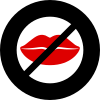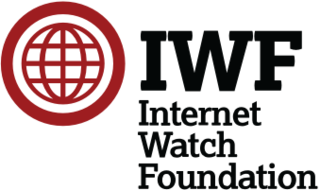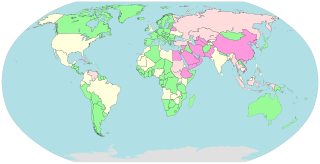This article needs additional citations for verification .(December 2010) |
| Part of a series on |
| Censorship by country |
|---|
 |
| Countries |
| See also |
Censorship in Finland refers to government policies in controlling and regulating certain information.
This article needs additional citations for verification .(December 2010) |
| Part of a series on |
| Censorship by country |
|---|
 |
| Countries |
| See also |
Censorship in Finland refers to government policies in controlling and regulating certain information.
In 1686, the office of Censor of Books, which was to monitor literature imported and published in Finland, was established. Publishers had to get approval for their books.
In the 19th century, the censors attacked the press. Several newspapers were stopped soon after they came out.
In 1829, a law was made about censorship, which heavily increased the censorship. The law was in place until 1865. A committee was made to take care of it. Its president was the deputy chancellor of the university.
During World War I, Russian censorship was carried out in the following cities: Helsinki, Tornio, Kuopio, Vaasa, Pori, Tampere, Turku, Rauma, Oulu and Viipuri.
At the end of 19th century during the attempt of Russification in Finland, several Finnish newspapers were taken out of print.
During the Second World War, a government agency was founded to administer censorship. [1]
In the immediate aftermath of the Continuation War, a number of books were withdrawn from public libraries because of Soviet pressure. This ban concerned mostly pre-war and wartime propaganda works which were considered anti-Soviet, but the books remained in free circulation in the second-hand market. In 1958, the memoirs Kommunisti sisäministerinä (“Communist as the Minister of Interior”) of former communist Minister of Interior Affairs Yrjö Leino were withdrawn from circulation and burned just before publication on Soviet demand. The book was republished in 1991.
During the period of Finlandization, major Finnish publishers tended to avoid books that were thought to risk Soviet displeasure. For example, the first volume of the Finnish translation of Aleksander Solzhenitsyn’s The Gulag Archipelago was published in Sweden, and the remaining two volumes by a minor Finnish publisher.
Film censorship carried out by the government agency Finnish Board of Film Classification was abolished in 2001. However, the agency still rates all movies sold in Finland. [2]

In 2006, a new copyright law known as Lex Karpela set some restrictions on publishing information regarding copy protection schemes.
Also in 2006, the government started Internet censorship by delivering Finnish ISPs a secret blocking list maintained by Finnish police. Implementation of the block was voluntary, but some ISPs implemented it[ citation needed ]. The list was supposed to contain only sites with child pornography, but ended up also blocking, among others, the site lapsiporno.info that criticized the move towards censorship and listed sites that were noticed to have been blocked.
Following a “voluntary law” [3] enacted by Finnish parliament on 1 January 2007, most of the Finland’s major Internet service providers decided on 22 November 2006 to begin filtering child pornography, and ISPs first started filtering in January 2008. The Ministry of Communications has commented that filtering is voluntary for ISPs as long as they do not refuse. The blacklist is provided by Finnish police and should contain only foreign sites. Technically filtering was planned to be URI based, like the United Kingdom’s Cleanfeed, but so far implementations have been DNS based.
A majority of these censored Internet sites, however, do not actually seem to be censored by the Finnish ISPs due to actual child pornography, but due to “normal” adult pornography instead. Most of the known sites are also located in EU or United States where child pornography is strictly illegal anyway. Two-thirds of the Finnish Internet censorship list of the filtered domains were collected on lapsiporno.info, [4] the homepage of Matti Nikki, a Finnish activist criticizing Internet censorship in the European Union and especially in Finland. On 12 February 2008, Nikki’s page was also added to the National Bureau of Investigation’s blacklist (Wikinews article). As the list was compiled using links from pornography sites, this list does not tell anything about the last third of the blocked sites.
At September 2008, problems with accuracy continued, when the website of the main international standards organization for the World Wide Web W3C was briefly blacklisted as child pornography by mistake. [5]
In 2008, a government-sponsored report considered establishing similar filtering in order to curb online gambling. [6]
After investigation of complaints about how the law on filtering child pornography has been implemented and the actions of the police, the vice Parliamentary Ombudsman concluded on 29 May 2009 that the police had followed the law and that most sites on the list did have material that could be classified as child pornography at the time they were investigated by the police. He also found that the law is somewhat unclear and that its effect on free speech is problematic and recommends these matters be considered when the law is overseen. [7]
In 2012, internet service providers Elisa, [8] Sonera (now Telia) [9] and DNA [10] were ordered by Finnish courts to block traffic to The Pirate Bay and put Internet filters on the specific website.
The Finnish press currently enjoys extensive freedom. [11] Reporters Without Borders' (RWB) annual Press Freedom Index listed Finland as the country with the freest press for six years in a row between 2010 and 2016. In 2017, Finland fell to third place following an incident dubbed "Sipilägate": Prime Minister Juha Sipilä had pressured the national broadcaster Yle when it had covered a possible conflict of interests concerning him. RWB Secretary General Christophe Deloire cited Finland losing the first place as the most important development in press freedom surveyed by the Index that year. [12]
An Internet filter is software that restricts or controls the content an Internet user is capable to access, especially when utilized to restrict material delivered over the Internet via the Web, Email, or other means. Content-control software determines what content will be available or be blocked.
Internet censorship in Australia is enforced by both the country's criminal law as well as voluntarily enacted by internet service providers. The Australian Communications and Media Authority (ACMA) has the power to enforce content restrictions on Internet content hosted within Australia, and maintain a blocklist of overseas websites which is then provided for use in filtering software. The restrictions focus primarily on child pornography, sexual violence, and other illegal activities, compiled as a result of a consumer complaints process.

Internet censorship is the legal control or suppression of what can be accessed, published, or viewed on the Internet. Censorship is most often applied to specific internet domains but exceptionally may extend to all Internet resources located outside the jurisdiction of the censoring state. Internet censorship may also put restrictions on what information can be made internet accessible. Organizations providing internet access – such as schools and libraries – may choose to preclude access to material that they consider undesirable, offensive, age-inappropriate or even illegal, and regard this as ethical behaviour rather than censorship. Individuals and organizations may engage in self-censorship of material they publish, for moral, religious, or business reasons, to conform to societal norms, political views, due to intimidation, or out of fear of legal or other consequences.
Most Internet censorship in Thailand prior to the September 2006 military coup d'état was focused on blocking pornographic websites. The following years have seen a constant stream of sometimes violent protests, regional unrest, emergency decrees, a new cybercrimes law, and an updated Internal Security Act. Year by year Internet censorship has grown, with its focus shifting to lèse majesté, national security, and political issues. By 2010, estimates put the number of websites blocked at over 110,000. In December 2011, a dedicated government operation, the Cyber Security Operation Center, was opened. Between its opening and March 2014, the Center told ISPs to block 22,599 URLs.
Internet censorship in the United Kingdom is conducted under a variety of laws, judicial processes, administrative regulations and voluntary arrangements. It is achieved by blocking access to sites as well as the use of laws that criminalise publication or possession of certain types of material. These include English defamation law, the Copyright law of the United Kingdom, regulations against incitement to terrorism and child pornography.
According to research done by the Organisation for Economic Co-operation and Development (OECD), the Netherlands is ranked with Switzerland in having the most broadband subscriptions per 100 inhabitants, has no bandwidth caps, and has the most homes passed in Europe in terms of connection speeds of 50 Mbit/s and higher.
The Internet in Sweden was used by 94.0% of the population, the fourth highest usage rate in the world, behind only the Falkland Islands (96.9%), Iceland (96.0%), and Norway (95%) in 2015. Sweden ranks 18th and 5th highest in the world in terms of the percentage of its fixed and wireless broadband subscriptions. It has the second fastest average internet connection speed in the world.
Censorship in Denmark has been prohibited since 1849 by the Constitution:
§ 77: Any person shall be at liberty to publish his ideas in print, in writing, and in speech, subject to his being held responsible in a court of law. Censorship and other preventive measures shall never again be introduced.

Lapsiporno.info is a Finnish website opposed to Internet censorship. The website was founded and is maintained by software developer, researcher and Internet activist Matti Nikki, who previously attracted international attention by analyzing Sony BMG's digital rights management rootkit that the company's products automatically installed on users' computers. The website focuses on the internet censorship in Finland, its effectiveness, and the issues and problems related to it.

The Internet Watch Foundation (IWF) is a global registered charity based in Cambridge, England. It states that its remit is "to minimise the availability of online sexual abuse content, specifically child sexual abuse images and videos hosted anywhere in the world and non-photographic child sexual abuse images hosted in the UK." Content inciting racial hatred was removed from the IWF's remit after a police website was set up for the purpose in April 2011. The IWF used to also take reports of criminally obscene adult content hosted in the UK. This was removed from the IWF's remit in 2017. As part of its function, the IWF says that it will "supply partners with an accurate and current URL list to enable blocking of child sexual abuse content". It has "an excellent and responsive national Hotline reporting service" for receiving reports from the public. In addition to receiving referrals from the public, its agents also proactively search the open web and deep web to identify child sexual abuse images and videos. It can then ask service providers to take down the websites containing the images or to block them if they fall outside UK jurisdiction.
On 5 December 2008, the Internet Watch Foundation (IWF), a British watchdog group, blacklisted content on the English Wikipedia related to Scorpions' 1976 studio album Virgin Killer, due to the presence of its controversial cover artwork, depicting a young girl posing nude, with a faux shattered-glass effect obscuring her genitalia. The image was deemed to be "potentially illegal content" under English law which forbids the possession or creation of indecent photographs of children. The IWF's blacklist are used in web filtering systems such as Cleanfeed.
Internet censorship in Ireland is a controversial issue with the introduction of a graduated response policy in 2008 followed by an effort to block certain file sharing sites starting in February 2009. Beyond these issues there are no government restrictions on access to the Internet or credible reports that the government monitored e-mail or Internet chat rooms. Individuals and groups could engage in the expression of views via the Internet, including by e-mail. Irish law provides for freedom of speech including for members of the press, and the government generally respects these rights in practice. An independent press, an effective judiciary, and a functioning democratic political system act jointly to ensure freedom of speech and of the press.
There is medium internet censorship in France, including limited filtering of child pornography, laws against websites that promote terrorism or racial hatred, and attempts to protect copyright. The "Freedom on the Net" report by Freedom House has consistently listed France as a country with Internet freedom. Its global ranking was 6 in 2013 and 12 in 2017. A sharp decline in its score, second only to Libya was noted in 2015 and attributed to "problematic policies adopted in the aftermath of the Charlie Hebdo terrorist attack, such as restrictions on content that could be seen as 'apology for terrorism,' prosecutions of users, and significantly increased surveillance."

In Russia, internet censorship is enforced on the basis of several laws and through several mechanisms. Since 2012, Russia maintains a centralized internet blacklist maintained by the Federal Service for Supervision of Communications, Information Technology and Mass Media (Roskomnadzor).
The precise number of websites blocked in the United Kingdom is unknown. Blocking techniques vary from one Internet service provider (ISP) to another with some sites or specific URLs blocked by some ISPs and not others. Websites and services are blocked using a combination of data feeds from private content-control technology companies, government agencies, NGOs, court orders in conjunction with the service administrators who may or may not have the power to unblock, additionally block, appeal or recategorise blocked content.
The child abuse image content list is a list of URLs and image hashes provided by the Internet Watch Foundation to its partners to enable the blocking of child pornography & criminally obscene adult content in the UK and by major international technology companies.

This list of Internet censorship and surveillance in Europe provides information on the types and levels of Internet censorship and surveillance that is occurring in countries in Europe.

This list of Internet censorship and surveillance in Asia provides information on the types and levels of Internet censorship and surveillance that is occurring in countries in Asia

This list of Internet censorship and surveillance in the Americas provides information on the types and levels of Internet censorship and surveillance that is occurring in countries in the Americas.

This list of Internet censorship and surveillance in Oceania provides information on the types and levels of Internet censorship and surveillance that is occurring in countries in Oceania.